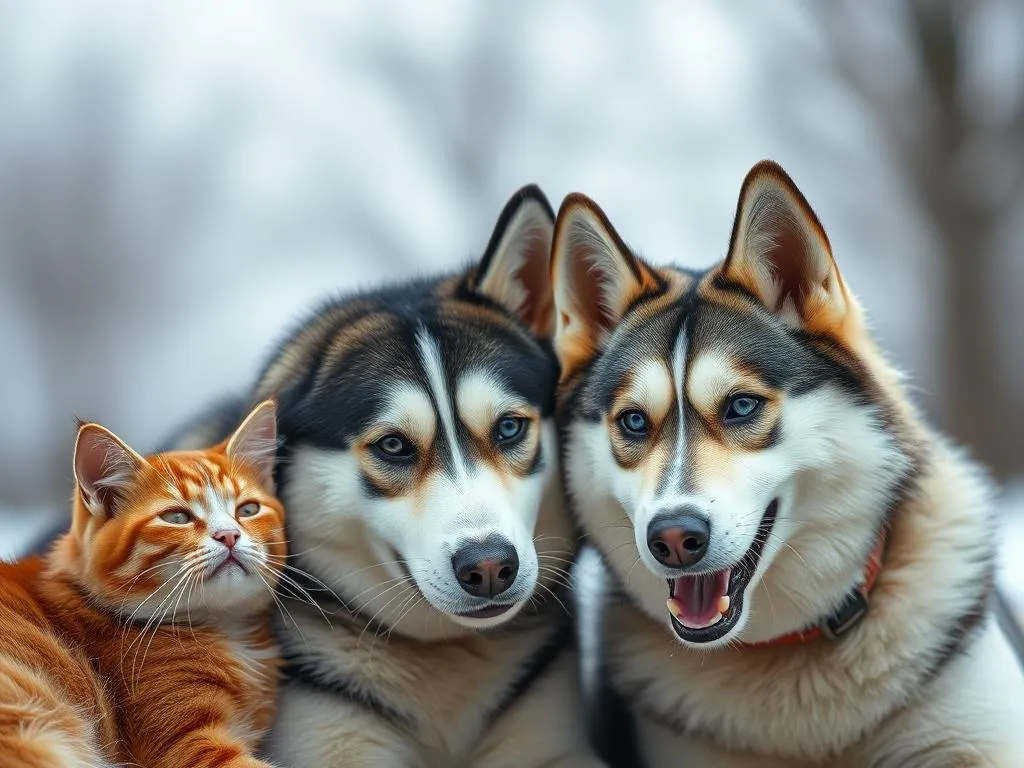
Siberian Huskies are a strikingly beautiful breed, known for their striking blue or multicolored eyes, thick double coats, and incredible energy. They are friendly, intelligent, and possess an independent streak that can sometimes challenge their owners. As pet owners, understanding compatibility between different animal species is crucial, especially if you’re considering introducing a Husky into a household that already has a cat. This brings us to the central question of this article: Do Huskies get along with cats? In this post, we will explore the characteristics of both breeds, factors influencing their compatibility, training techniques, and signs of positive interactions.
Understanding Siberian Huskies
Breed Characteristics
Siberian Huskies are medium-sized working dogs with a robust and athletic build. They typically weigh between 35 to 60 pounds and stand about 20 to 24 inches tall at the shoulder. Their thick fur is designed to protect them from harsh climates, and they come in a variety of colors, including black, gray, red, and agouti.
In terms of personality, Huskies are known for being friendly, energetic, and independent. They thrive on human interaction and enjoy being part of family activities. However, their independent nature can lead to stubbornness, making training a challenge if not approached correctly.
Common Behavioral Traits
One notable characteristic of the Husky breed is their high prey drive. This instinct can be a significant factor when considering their compatibility with cats. Huskies are natural hunters, and without proper training and socialization, they may see cats as prey rather than companions.
Socialization is another critical aspect of a Husky’s behavior. These dogs generally enjoy the company of other animals, especially if introduced at an early age. Proper exercise and mental stimulation are also vital for Huskies, as they require plenty of physical activity to prevent boredom and destructive behaviors.
Understanding Cats
Breed Characteristics
Cats are often perceived as independent, and while this is mostly true, their personalities can vary significantly based on their breed. For instance, breeds like the Siamese are known for being vocal and social, while Persians tend to be more reserved and calm. Overall, cats exhibit a range of traits, but they typically value their territory and may be less inclined to share their space with a new dog.
Common Behavioral Traits
Cats are natural hunters, and their instincts drive them to explore and assert their territory. Their behavior can be influenced by their environment and early socialization experiences. A well-socialized cat is more likely to adapt to a new pet in the home, while a cat that has not been exposed to other animals may react defensively.
Understanding a cat’s natural instincts is essential in determining how it will respond to a Husky. A cat’s tendency to scratch or hiss when feeling threatened can lead to misunderstandings if the dog is overly curious or playful.
Factors Influencing Compatibility
Early Socialization
Early socialization is crucial in determining whether Huskies and cats can live harmoniously together. Introducing them at a young age significantly increases the likelihood of a positive relationship. Here are some tips for successful introductions:
- Gradual Exposure: Allow both pets to see each other from a distance before allowing face-to-face interactions.
- Controlled Environment: Use leashes for the Husky and a safe space for the cat to retreat if they feel overwhelmed.
- Positive Reinforcement: Reward both pets with treats and praise during positive interactions to encourage good behavior.
Individual Temperament
Each animal has its own personality, which plays a significant role in their compatibility. Some Huskies may have a lower prey drive and be more tolerant of cats, while others may be more inclined to chase. Similarly, some cats may be more social and adaptable, while others are more territorial and fearful.
Anecdotal evidence shows that successful pairings often occur when both pets have calm temperaments. For example, a laid-back Husky paired with a confident cat may thrive, while a hyperactive Husky with a skittish cat may lead to conflict.
Environment and Living Space
The home environment can greatly affect how Huskies and cats interact. A spacious area allows pets to establish their territory and retreat from one another when needed. Creating a pet-friendly environment may include:
- Separate Areas: Designate separate areas for both pets to retreat to when they need space.
- Vertical Space for Cats: Provide cat trees or shelves for cats to escape to high ground, where they may feel safer.
- Safe Zones: Ensure that both pets have access to safe zones in the house where they can feel secure.
Training and Behavior Management
Basic Training Techniques for Huskies
Training a Husky is essential in promoting positive interactions with cats. Here are some effective training methods:
- Basic Commands: Teach your Husky basic commands like “sit,” “stay,” and “leave it.” This can help manage their excitement and curiosity toward the cat.
- Consistency: Be consistent with commands and rules to reinforce good behavior.
- Socialization Classes: Enrolling your Husky in socialization classes can provide exposure to other animals and help them learn appropriate behaviors.
Behavior Modification for Cats
Cats can also benefit from behavior modification techniques to help them feel secure around Huskies:
- Safe Spaces: Create hiding spots for cats, such as boxes or designated rooms, where they can escape if they feel threatened.
- Feliway Diffusers: Using products like Feliway diffusers can help reduce stress and anxiety in cats by emitting calming pheromones.
- Encourage Play: Engage cats in play using toys that allow them to maintain distance from the Husky, helping them feel more secure.
Signs of Positive Interaction
Body Language of Both Pets
Understanding the body language of Huskies and cats is critical in recognizing positive interactions. Key indicators of comfort and acceptance include:
- Huskies: A relaxed body posture, wagging tail, and soft eyes indicate a friendly demeanor.
- Cats: A cat that approaches with a relaxed body and tail held high is likely comfortable. Purring and gentle kneading are also positive signs.
Positive Play and Bonding
Engaging both pets in activities that promote bonding can help foster a positive relationship. Here are some suggestions:
- Interactive Toys: Use toys that require both pets to work together, encouraging cooperation.
- Supervised Playtime: Allow short periods of supervised playtime where both pets can interact under careful observation.
- Joint Training Sessions: Conduct training sessions that include both pets, rewarding them for calm behavior in each other’s presence.
Potential Challenges and Solutions
Common Issues Encountered
While many Huskies and cats can coexist peacefully, certain challenges may arise. Common issues include:
- Chasing: A Husky may instinctively chase a cat, leading to stress and potential injury.
- Scratching: A cat may scratch or hiss at a Husky if it feels cornered or threatened.
Recognizing signs that indicate a need for intervention is key. If either pet shows signs of extreme stress or aggression, it may be time to reassess their living arrangements.
Solutions and Strategies
Managing conflicts between Huskies and cats requires patience and strategic interventions:
- Redirect Behavior: If a Husky starts to chase, redirect their attention with a toy or command.
- Controlled Separation: If tensions rise, temporarily separate the pets until they can calm down.
- Professional Help: If issues persist, consider seeking assistance from a professional trainer or animal behaviorist who specializes in multi-pet households.
Conclusion
In summary, the question Do Huskies get along with cats? largely depends on various factors such as early socialization, individual temperaments, and the living environment. While Huskies have a natural prey drive, with proper training, socialization, and understanding of both breeds’ behaviors, many pets can coexist happily. It’s essential for pet owners to consider their individual pets’ needs and personalities, allowing for a harmonious home where both Huskies and cats can thrive together.
Creating a safe and supportive environment, along with consistent training and positive interactions, can lead to a successful relationship between your Husky and cat. Ultimately, patience and understanding are key to ensuring that both pets can enjoy a peaceful coexistence.









